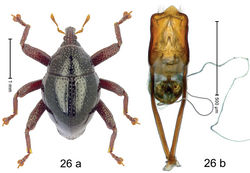Trigonopterus heberti
| Notice: | This page is derived from the original publication listed below, whose author(s) should always be credited. Further contributors may edit and improve the content of this page and, consequently, need to be credited as well (see page history). Any assessment of factual correctness requires a careful review of the original article as well as of subsequent contributions.
If you are uncertain whether your planned contribution is correct or not, we suggest that you use the associated discussion page instead of editing the page directly. This page should be cited as follows (rationale):
Citation formats to copy and paste
BibTeX: @article{Riedel2019ZooKeys, RIS/ Endnote: TY - JOUR Wikipedia/ Citizendium: <ref name="Riedel2019ZooKeys">{{Citation See also the citation download page at the journal. |
Ordo: Coleoptera
Familia: Curculionidae
Genus: Trigonopterus
Name
Trigonopterus heberti Riedel sp. n. – Wikispecies link – ZooBank link – Pensoft Profile
Diagnostic description
Holotype, male (Fig. 26a). Length 2.46 mm. Color of antennae and legs ferruginous; remainder black. Body subovate; in dorsal aspect with weak constriction between pronotum and elytron, in profile dorsally convex. Rostrum dorsally with median and pair of submedian ridges; intervening furrows with sparse rows of suberect setae; epistome short, posteriorly with transverse, angulate ridge. Pronotum with median, densely punctate swelling; submedially disk with pair of broad, sparsely punctate depressions; interspaces between punctures subglabrous. Elytra with striae marked by rows of minute punctures; basal margin bordered by transverse row of deeper punctures; stria 8 along humerus with six large, coarse punctures; sutural interval with additional row, other intervals subglabrous, with few interspersed punctures; elytral apex subangulate. Femora edentate; anterior surface densely coarsely punctate, each puncture with recumbent scale. Metafemur with dorsoposterior edge denticulate, with silvery-yellowish scales upcurved; subapically with stridulatory patch. Abdominal ventrite 1 and anterior portion of ventrite 2 concave, cavernous, subglabrous; ventrite 2 posteriorly forming rim; ventrite 5 broadly concave, sparsely punctate. Penis (Fig. 26b) subapically with fringe of sparse setae, medially with angulate extension; dorsum with submedian brushes of setae; apodemes 1.7 × as long as body of penis; transfer apparatus with complex sclerites; ductus ejaculatorius without bulbus. Intraspecific variation. Length 2.26–2.46 mm. Female rostrum in apical 1/2 slender, subglabrous, with two submedian rows of punctures, with pair of sublateral furrows. Female abdominal ventrite 5 flat, sparsely punctate, setose.
Material examined
Holotype (MZB): ARC2885 (GenBank # MK2 60352), N-Sulawesi Prov., Kotamobagu, Matalibaru, 00°32.445'N 124°14.185'E, 956 m, beaten, 20-V-2012. Paratypes (MZB, SMNK): N-Sulawesi Prov.: 1 ex, ARC2887 (GenBank # MK260348), same data as holotype; 3 exx, ARC2903 (GenBank # MK260349), ARC2904 (GenBank # MK260350), ARC2910 (GenBank # MK260353), Kotamobagu, Modoinding, Lake Moat area, 00°42.862'N 124°28.356'E, 1024 m, sifted, 19-V-2012; 1 ex, ARC2756 (GenBank # MK260351), Tomohon, Rurukan, Gn. Mahawu, 01°21.409'N 124°51.535'E to 01°21.370'N 124°51.676'E, 1126–1231 m, 14-V-2012.
Distribution
N-Sulawesi Prov. (Kotamobagu, Lake Moat, Tomohon). Elevation 960–1130 m.
Biology
On foliage in montane forests.
Etymology
This species is named in honor of Prof. Paul DN Hebert (University of Guelph) for establishing “DNA barcoding” as a tool in taxonomic practice. An invariable genitive.
Notes
Trigonopterus heberti Riedel, sp. n. was coded as “Trigonopterus sp. 411”.
Original Description
- Riedel, A; Narakusumo, R; 2019: One hundred and three new species of Trigonopterus weevils from Sulawesi ZooKeys, (828): 1-153. doi
Images
|
